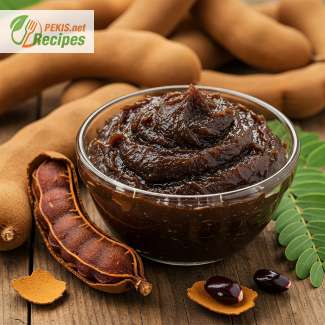
The Ultimate Guide to Tamarind Paste: Everything You Need to Know
What is Tamarind Paste?
Tamarind paste is a thick, dark, and tangy condiment derived from the tamarind fruit, which grows in pods on the Tamarindus indica tree. This paste is a staple ingredient in various global cuisines, particularly in South Asian, Middle Eastern, and Latin American dishes. Known for its sweet and sour profile, tamarind paste is often used to enhance the flavors of curries, sauces, soups, and marinades.
Characteristics of Tamarind Paste
- Color: Deep brown to dark reddish-brown.
- Texture: Thick, sticky, and smooth.
- Taste: A perfect balance of sweetness and tanginess with a hint of acidity.
- Aroma: Earthy, slightly fruity with citrus undertones.
- Shelf Life: Can last several months when properly stored in the refrigerator.
Why is Tamarind Paste Used?
Tamarind paste is widely used for its unique flavor-enhancing properties. It is incorporated in:
- Culinary applications – Used in soups, sauces, and curries.
- Beverages – Found in drinks like tamarind juice and tamarind-flavored sodas.
- Condiments – Key ingredient in Worcestershire sauce and chutneys.
- Traditional medicine – Recognized for its digestive and anti-inflammatory benefits.
How is Tamarind Paste Used in Cooking?
Tamarind paste is a versatile ingredient that can be used in various ways:
- Curries and Soups: Enhances the depth of flavor in dishes like Thai Tom Yum soup and Indian sambar.
- Sauces and Marinades: Adds a rich tang to barbecue sauces, chutneys, and meat marinades.
- Beverages: Mixed with water and sweeteners to create refreshing drinks.
- Desserts: Used in candies and sweet dishes for a contrasting tartness.
- Pickles and Chutneys: Provides a bold sour note that complements other spices.
- Street Food: Common in dishes like Pani Puri and Pad Thai.
Health Benefits of Tamarind Paste
Tamarind paste offers numerous health advantages, making it a valuable addition to any diet:
- Rich in Antioxidants: Helps fight free radicals and reduces oxidative stress.
- Aids Digestion: Contains natural laxatives that promote healthy digestion.
- Supports Heart Health: Helps in lowering bad cholesterol (LDL) and improving blood circulation.
- Regulates Blood Sugar: Can help in managing diabetes by reducing blood sugar spikes.
- Boosts Immunity: Packed with vitamin C and antimicrobial properties.
- Anti-inflammatory Properties: Helps reduce inflammation and joint pain.
How Does Tamarind Paste Work?
Tamarind paste is highly acidic, which allows it to break down proteins in meats and enhance their tenderness. The pectin and fiber content aids in digestion, while its natural tartness balances out rich and spicy dishes. In traditional medicine, it is used as a natural remedy for fevers, digestive issues, and skin problems.
Secrets to Using Tamarind Paste Effectively
- Dilution is Key: A little goes a long way; always dilute it before adding to dishes.
- Pair with Sweeteners: Combining it with honey or sugar enhances its complex flavor profile.
- Use as a Meat Tenderizer: Its acidity softens tough meat fibers.
- Balance with Other Spices: Works well with cumin, coriander, and chili powders.
- Make Homemade Tamarind Water: Mix tamarind paste with warm water for a quick, flavorful addition to soups and stews.
Why is Tamarind Paste So Good for Recipes?
Tamarind paste is valued for its ability to enhance umami flavors in various dishes. Its unique sweet and sour balance creates depth in sauces, stews, and even desserts. The natural acidity helps in tenderizing meats, making it a key ingredient in many marinades. Whether used in classic Asian dishes, Latin American cuisine, or Mediterranean specialties, tamarind paste is an indispensable kitchen staple.
Home Cultivation and Harvesting of Tamarind
Growing tamarind trees requires warm climates and well-drained soil. Here’s how you can cultivate tamarind at home:
- Planting: Use fresh tamarind seeds and soak them in warm water for 24 hours before planting.
- Sunlight & Water: Requires full sun exposure and moderate watering.
- Growth Duration: Takes 5-7 years to bear fruit.
- Harvesting: When the pods turn brown and dry, they are ready to be collected.
- Processing: The pulp is removed from the pods, cleaned, and then mashed into paste.
Nutritional Values of Tamarind Paste
- Calories: 287 kcal per 100g
- Carbohydrates: 62g
- Protein: 2.8g
- Fats: 0.6g
- Fiber: 5.1g
- Sugar: 57g
Vitamins and Minerals in Tamarind Paste
- Vitamin C – Boosts immunity and skin health.
- Vitamin B1, B2, B3 – Supports metabolism and brain function.
- Iron – Essential for red blood cell production.
- Magnesium – Helps in muscle relaxation and nerve function.
- Potassium – Regulates blood pressure and muscle function.
- Calcium – Strengthens bones and teeth.
- Phosphorus – Aids in energy production and cellular repair.
Additional Information About Tamarind Paste
- Storage Tips: Store in an airtight container in the refrigerator for maximum freshness.
- Substitutes: If tamarind paste is unavailable, try lemon juice mixed with brown sugar as an alternative.
- Cooking Precautions: Too much tamarind can make a dish overly sour; always add in small amounts and adjust as needed.
- Culinary Pairings: Complements coconut milk, fish sauce, ginger, and garlic.
- Cultural Uses: Used in traditional medicine to treat fevers, digestive problems, and even as a skincare remedy.
Why You Should Use Tamarind Paste
Tamarind paste is a powerhouse ingredient that enhances flavor, provides health benefits, and is incredibly versatile in cooking. Whether you are making a spicy curry, a refreshing drink, or a traditional sauce, this paste is a must-have in any kitchen. By learning to use it effectively, you can unlock new dimensions of taste in your dishes while reaping its numerous health advantages. If you haven't tried tamarind paste yet, now is the perfect time to add it to your pantry and explore its amazing culinary potential!